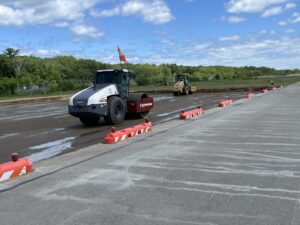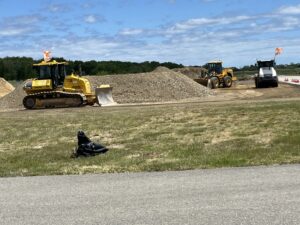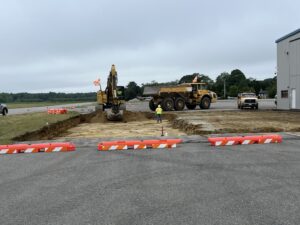Initial rounds of KGHG ramp repave project near completion

The east ramp and mid-ramp area by Shoreline Aviation’s jet hangar are soon to be paved. When that happens, and the gleaming black asphalt solidifies into a completed section of Marshfield Municipal Airport’s safety improvement project, observers close to the project can collectively exhale – 23 years after it became a gleaming goal of the town and its airport commissioners and 11 years since previous work was done.
Lawrence Lynch Corp. has been digging, pushing, mixing, and grading soil since early June. Lynch has been working with P154 soil, a sub-base material that provides a strong, stable base to support the layers above it, typically in paving applications and in airports.
The company will add a layer of P209 soil on top of the P154. P209 is a crushed aggregate base course designed to go on a prepared surface and provide a stable foundation.

The base soil layer is prepped to take another layer before paving the east ramp.
“Once the P209 is approved, we’ll pave,” said Nick Prescott. Nick is the resident project representative with Airport Solutions Group. ASG is the airport’s consulting firm who designed the project.
The east ramp and jet hangar ramp area will be paved at the same time, he said, finally filling the deep 32-inch cuts. This scheduling ensures that Shoreline Aviation’s managed fleet will remain flying with little interruption other than some minimal taxiing logistics. How will this work? Assistant Airport Manager Ben Garman explains.
“The aircraft will taxi out onto the Bravo taxiway and out onto the runway, then back taxi, which is taxiing in the opposite direction that the aircraft departs, to taxiway Charlie, then to taxiway Alpha to depart normally off Runway 2-4 (northeast to southwest),” Ben said. “When they depart Runway 6 (southwest to northeast) they will just taxi normally down to the end of Alpha to runway 6 to depart.
“When they land Runway 2-4, they get off at Alpha and taxi normally onto the ramp. When they land Runway 6, they have to back taxi Runway 2-4 to Bravo to get off onto the ramp.”
Alpha is the main taxiway that runs the length of the airport, parallel to the runways, Ben explained. Bravo is the little cross section taxiway that enters onto the main ramp a third of the way along runway 6.
“That’s how aircraft enter and exit the main ramp normally,” he said. “Charlie is the third stub, which is about two-thirds down runway 6, and that gets off onto Alpha as well.”

Soils and stone are mixed to make a solid base for the east ramp.
The midsection of Alpha has been closed to traffic during the construction on the east ramp and the jet hangar.
The first phase of the safety improvement project saw the construction of a new runway 3,900 feet long, compared to the former runway’s 3,000 feet. Also, the runway was widened from 75 feet to 100 feet. These were deemed important safety measures, allowing aircraft to take off and land more safely.
Enhancing airport safety is a high priority for the Airport Commission and airport fixed base operator Shoreline Aviation, as well as the FAA and MassDOT’s Aeronautics Division, which fund and administer a grant, respectively, financing most of the project. This project brings the airport to current FAA standards.

A 32-inch cut is being made into the ramp area next to Shoreline Aviation’s jet hangar.
The runway phase concluded in 2014. Next up, the asphalt ramp – or the open paved area where aircraft park, load, fuel, tie down, and traverse to access the runway area – will be removed and replaced.
This project is part of the Land Use with Higher Potential Pollutant Loads (LUHPPL) initiative, a conditional order to the runway program. It is a complete reconstruction and improvement of the main ramp to its borders with Taxiway Alpha, and it is essential to ensure continued operational safety and environmental compliance.
When the main ramp is being worked, aircraft owners and charter clients will be asked to park in front of the terminal building on Old Colony Lane, and Shoreline personnel will transport them to access hangars and departure locations. The normal access at Gate 2 (next to the terminal) will be closed during this phase. The entire project is expected to be finished in September – a long time after that initial germ of an idea 23 years ago.
Back to News